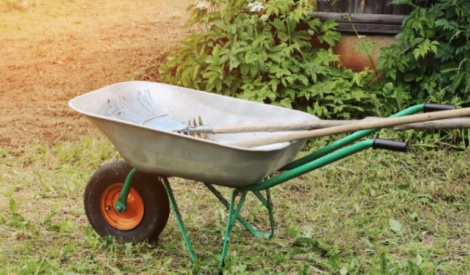- All
- Product Name
- Product Keyword
- Product Model
- Product Summary
- Product Description
- Multi Field Search
Please Choose Your Language
Views: 0 Author: Site Editor Publish Time: 2025-05-14 Origin: Site









Choosing the right wheelbarrow involves considering the tasks you'll use it for most often. Both metal and plastic wheelbarrows have unique strengths and weaknesses. Whether you're a gardener or a construction professional, understanding these differences can help you choose the best wheelbarrow for your needs.
Plastic wheelbarrows are increasingly popular for lighter, residential tasks, offering convenience and ease of use that many homeowners appreciate.
Plastic wheelbarrows are significantly lighter than their metal counterparts, making them easier to handle, especially for individuals with limited physical strength. Paired with high-quality plastic wheels or PU wheels, they offer smooth maneuverability even over uneven terrain.
A significant advantage of plastic wheelbarrows is their resistance to corrosion. Unlike metal, plastic doesn't rust, allowing these wheelbarrows to be stored outdoors without additional maintenance or worry about rusting.
Plastic wheelbarrows are low-maintenance. You only need to rinse them occasionally to keep them clean. They require no painting or rust prevention treatments.
Plastic wheelbarrows are budget-friendly, making them ideal for casual users who don't require industrial strength. They’re often the preferred choice when searching for an affordable wheelbarrow for sale.
Plastic wheelbarrows offer good shock absorption, which helps when transporting sensitive materials like soil, plants, or compost. This flexibility can reduce user fatigue during prolonged use.
However, plastic wheelbarrows aren’t ideal for heavy or sharp materials. They may crack under extreme stress or temperature variations, limiting their use in harsh environments.
Steel wheelbarrows are preferred for their ruggedness and ability to handle demanding tasks. They're a common choice for construction sites and landscaping businesses.
A heavy duty wheelbarrow made of steel excels in strength and durability. Steel can handle heavy loads like concrete, stones, and bricks without deforming.
Steel wheelbarrows can withstand sharp and abrasive materials better than plastic. They resist punctures, cuts, and heavy impacts, making them ideal for industrial use.
Though initially more expensive, steel wheelbarrows are a better long-term investment due to their longevity. Properly maintained, a metal wheelbarrow can last for decades.
Steel wheelbarrows typically have better balance and stability under heavy loads, particularly when fitted with durable rubber wheels or flat-free PU wheels. This provides greater control, reducing the chance of tipping.
The main disadvantages are their heavier weight and susceptibility to rust, especially if not properly cared for or stored correctly. They can be cumbersome to maneuver when empty.

For garden tasks, plastic wheelbarrows are generally preferred due to their lightweight design, ease of use, and resistance to rust. They handle garden materials effectively without unnecessary strain.
Steel wheelbarrows are unquestionably the best choice for heavy-duty tasks such as construction or extensive landscaping work. They reliably carry heavy loads without structural compromise.
For mixed-use scenarios, consider a steel wheelbarrow with lightweight design features or high-quality plastic models with reinforced frames. Wheelbarrows with versatile PU wheels provide a good middle ground, suitable for various terrains.
Quality significantly impacts performance and durability. High-quality wheelbarrows have features like reinforced trays, solid frames, and reliable wheelbarrow wheels.
Premium plastic wheelbarrows often include UV protection to resist cracking and fading. High-quality steel wheelbarrows frequently come with powder coatings or galvanization for rust resistance. The frame, tray thickness, and wheel type greatly influence overall performance and longevity.
Plastic wheelbarrows are lightweight, affordable, corrosion-resistant, and easy to maintain, making them highly practical for casual home use.
Choose plastic for occasional gardening and home tasks; select metal if you regularly handle heavy or sharp materials. Assessing your typical workload and frequency of use will guide you toward the best wheelbarrow for your situation.
Neither type is universally better—it depends entirely on your specific needs. Plastic excels for ease of use, affordability, and light tasks. Metal is unmatched for heavy-duty usage, durability, and longevity.
Q1: Should I get a plastic or metal wheelbarrow?
A1: Plastic for casual use; metal for heavy, frequent tasks.
Q2: What is the best material for a wheelbarrow?
A2: Plastic for garden use, metal for construction and heavy loads.
Q3: Do plastic wheelbarrows work?
A3: Yes, they work well for gardening, landscaping, and light-duty tasks.
Q4: What should I consider when buying a wheelbarrow?
A4: Consider material, wheel type, tray capacity, durability, and intended tasks.
Q5: Plastic vs. Steel Wheelbarrows: Which is the Best for Your Wallet?
A5: Plastic is cheaper initially; steel saves money long-term due to durability.
Q6: What size wheelbarrow is best?
A6: 6-8 cubic feet is suitable for general use, while larger sizes are better for construction.
Q7: Where can I find a reliable wheelbarrow for sale?
A7: Yongyi Metal offers both durable metal and lightweight plastic wheelbarrows suitable for various applications, equipped with reliable wheels for all terrains.